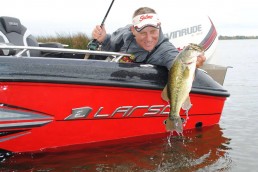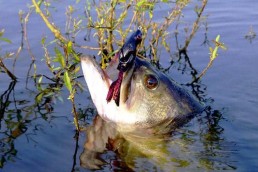Do Battle with Big Bass on Summer Flats
SHARE THIS POST
Lots of Midwestern bass anglers, myself included, like to fish the deep or outside edges of the weedline utilizing spinning gear and jig and worm-style baits. Jig-worming the deep weedline is in fact a favorite technique for guides who prefer this method for its simplicity and the number of bass and other species often caught.
At times, however, the bite can be better, especially for big bass by fishing up on the flat and penetrating the heaviest weed clumps. Here are some tips if you decide to go to battle with the big bass inhabiting the flats in summer.
Late and early in the day, or on cloudy, windy days, you will often find numbers of bass prowling the weed edges. When the sun is high and the wind stays flat, or is very light and variable, this is a prime time for bass to pull up onto a flat and bury themselves in some of the thickest, nastiest vegetation available. When that is the case, I dig out a flipping stick, tie on a big jig and start making short pitches to heavy weed clumps.
Sometimes, especially on large flats, the search can go quite some time without a bite, when suddenly several bass are caught in succession from a very small area. When that happens I try to identify what made the particular area “fishy.” Maybe it was a very dense patch of weeds, a change in weed type or a small opening in the weeds that held them. Another indicator might be water depth, as often identifying a particular depth range where the bites come from can narrow a search, especially on flats with some gradual depth tapering.
Are you enjoying this post?
You can be among the first to get the latest info on where to go, what to use and how to use it!
Whatever the case, I thoroughly fish a productive area trying to maximize my bites, and then move on searching for similar spots that yield similar results.
My jig presentation for this style utilizes a big, skirted bass jig with a soft plastic trailer. I prefer a 5/8-ounce Jungle Jig in Black and Blue if the water is somewhat off-color, and I utilize the same jig in the Pumpkin Craw if the water is a bit clearer. I tip the jig with a plastic chunk-style trailer and pitch it out ahead of the boat, let it settle in and hop or shake it a couple times before reeling up and repeating. Often, the bite comes on the initial drop or shortly after, so I don’t spend too much time working the bait before reeling up and making my next pitch. Also, the Jungle Jig’s sleek bullet head works great for penetrating heavy vegetation.
Another important equipment consideration in heavy cover is the rod, reel and line. A heavy-action flipping stick and high- speed baitcasting reel spooled with braided line works great. Recently, I have been using Cabela’s Arachnid Casting Rod and Baitcasting Reel. The 7 1/2-foot, extra-fast action, heavy-power Arachnid rod paired with the 8.1 gear ratio reel gives me the power I need to horse big fish from heavy cover. It also lets me retrieve line rapidly when searching for bass. Spooling with 50-pound-test Sunline FX2 braid completes the setup.
If you’re going for big fish this summer, consider visiting the flats on your favorite lake and utilizing some of these tips. Odds are good you will tangle with some big bass and have some big fun. Enjoy your time on the water and remember to include a youngster in your next outdoors adventure. MWO
MWO
SHARE THIS POST
Did you enjoy this post?
You can be among the first to get the latest info on where to go, what to use and how to use it!
Mike Frisch
Mike Frisch is a lifelong angler who has been guiding anglers in western Minnesota for nearly three decades. Mike co-hosts the popular Fishing the Midwest television series and co-founded School of Fish, a leading fishing education program. Learn more by visiting fishingthemidwest.com or following “Fishing the Midwest” on Facebook.


